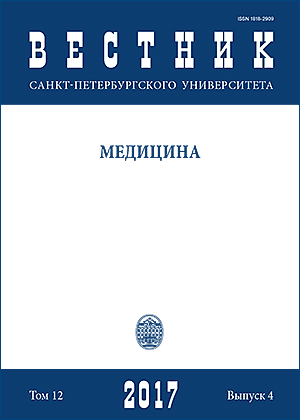НЕТРОМБОТИЧЕСКИЕ ОСЛОЖНЕНИЯ ПОСТОЯННОГО СОСУДИСТОГО ДОСТУПА ПРИ ПРОГРАММНОМ ГЕМОДИАЛИЗЕ И СПОСОБЫ ИХ ХИРУРГИЧЕСКОЙ КОРРЕКЦИИ
DOI:
https://doi.org/10.21638/11701/spbu11.2017.404Аннотация
В статье дается обзор современных представлений о диагностике и тактике лечения основных осложнений артериовенозного доступа, не связанных с его тромботической окклюзией. Обсуждаются вопросы хирургического лечения инфекционных и гемодинамических осложнений, лечебная тактика при аневризматической трансформации сосудистого доступа. Стремительное развитие технологий хронического гемодиализа позволило не только сохранить жизни миллионам пациентов, страдающих хронической почечной недостаточностью, но и значительно улучшить параметры качества жизни. Совершенствование медицинской техники, лечебных алгоритмов и возможностей медикаментозного замещения утраченных почечных функций, а также снижение стоимости лечения хроническим гемодиализом привели к повышению доступности данного вида коррекции терминальной почечной недостаточности. Артериовенозный доступ к гемодиализу, определивший возможность длительного
эффективного канюлирования периферических сосудов, был и остается основным «ключом» к адаптации системы гемоциркуляции пациента с аппаратом «искусственная почка». Будучи, с одной стороны, несомненным благом для пациента, артериовенозный доступ является, тем не менее, искусственным патологическим образованием, приводящим к формированию ряда специфических синдромов. Экспоненциальное расширение клинической практики хронического гемодиализа, а значит, и увеличение количества формируемых артериовенозных доступов определяют значимость исследований вызываемых ими осложнений. Актуальность их изучения для гемодиализа во многом обусловлена увеличением среднего возраста пациентов и продолжительности получаемого ими лечения. Тогда как традиционные хирургические операции в сосудистой хирургии активно замещаются эндоваскулярными вмешательствами, число операций формирования и реконструкций артериовенозного доступа продолжает расти. Библиогр. 67 назв.
Ключевые слова:
гемодиализ, постоянный сосудистый доступ, артериовенозная фистула, венозная гипертензия, аневризмы, перипротезная серома, ишемическая односторонняя нейропатия
Скачивания
Библиографические ссылки
References
aureus infections among dialysis patients — United States, 2005. MMWR Morb. Mortal Wkly Rep., 2007,no. 56, p. 197.
A clustering of epidural abscesses in chronic hemodialysis patients: risks of salvaging access catheters in cases of infection. J. Am. Soc. Nephrol., 1996, no. 7, p. 2264.
infection with topical intranasal mupirocin: an evidence-based review. Clin. Infect. Dis., 2003, vol. 37,p. 933.
A comparison between PTFE and denatured homologous vein grafts for haemodialysis access: a prospective randomisedmulticentre trial. The SMASH Study Group. Study of graft materials in access for haemodialysis. Eur. J. Vasc. Endovasc. Surg., 1998, no. 16, p. 126.
preoperative evaluation of the subclavian vein in dialysis access planning. AJR Am. J. Roentgenol., 1991,no. 156, pp. 623–625.
Gregory R. T., Rutherford R. B., Kent K. C. Recommended standards for reports dealing with arteriovenous hemodialysis accesses. J. Vasc. Surg., 2002, no. 35, pp. 603–610.
and peripheral venous obstruction: a long-term multi-institutional experience. J. Vasc. Surg., 2000, no. 32,pp. 760–769.
vein interposition for salvage of a functioning arteriovenous fistula. Ann. Vasc. Surg., 2000, no. 14,pp. 679–682.
placement. J. Am. Coll. Surg., 2006, no. 203, pp. 506–511.
, 2008,no. 48, pp. 216–217.
Thomas, E. H. Lambert. 2nd ed. Philadelphia, 1984, pp. 1811–1825.
Acute cardiac failure secondary to brachiocephalic arteriovenous fistula in patient on chronic haemodialysis.
Pol. Arch. Med. Wewn., 2004, no. 112, p. 1221.
Long-term effects of arteriovenous fistula closure on echocardiographic functional and structural findings
in hemodialysis patients: a prospective study. Am. J. Kidney Dis., 2010, no. 55, p. 682.
Kooman J. P. The relation between vascular access flow and different types of vascular access with systemic
hemodynamics in hemodialysis patients. Artif Organs, 2005, no. 29, p. 960.
Hypertens., 2006, no. 15, pp. 353–360.
Kidney Int., 2006, no. 70, p. 765.
Dial.Transplant., 1984,no.13, pp. 635–638.
Brown S. T., McDonald J. C. Complications from permanent hemodialysis vascular access. Surgery, 1988,no. 104, pp. 681–686.
Reboldi G. Survival of vascular access during daily and three times a week hemodialysis. Clin.
Nephrol.,2000, no. 53, p. 372.
hemodialysis graft with placement of a stent graft. Semin. Interv. Radiol., 2007, no. 24, pp. 34–37.
salvaging failing dialysis access. Vasc. Endovasc. Surg., 2008, vol. 42, no. 3, pp. 228–234.
Загрузки
Опубликован
Как цитировать
Выпуск
Раздел
Лицензия
Статьи журнала «Вестник Санкт-Петербургского университета. Медицина» находятся в открытом доступе и распространяются в соответствии с условиями Лицензионного Договора с Санкт-Петербургским государственным университетом, который бесплатно предоставляет авторам неограниченное распространение и самостоятельное архивирование.




